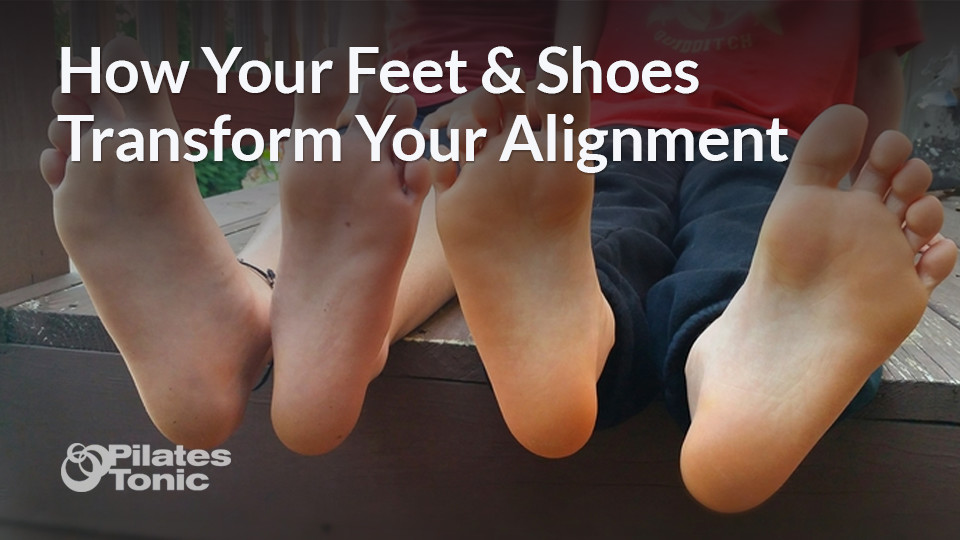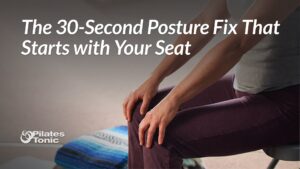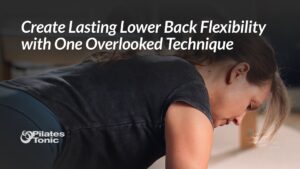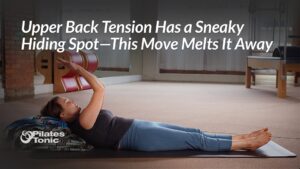
Looking back at my kids' early physical development and knowing what I've learned since then about early-stage alignment, I would have changed everything about their shoes!
My family humors me every day when I remind them to sit on their sitting bones or ask them to walk instead of riding a bike. And when it comes to shoes, I am incredibly particular about what they wear.
A little over five years ago I began to understand how shoes impact the human body in ways I'd never considered. That's when I started transitioning myself and my kids into minimal shoes.
Minimal shoes have flexible soles, a wide toe box, zero heel elevation, and no arch support. They allow for as much natural movement of the foot as possible when walking and running.
“Our feet form the direct connection through the entire body to challenge gravity.”
My daughter was six when she started going barefoot more frequently and wore her first pair of minimal shoes.
Over the years, she’s gotten questions from her peers and been told by other kids that they could never wear the shoes she wears because they are too flat and don’t have enough support.
The other day she asked me to explain why the type of shoes we wear matter so much and I could tell she truly wanted to understand for her own knowledge, and so she could respond when people ask her questions.
I was elated because, normally, when I start talking about alignment, feet and sitting bones, her eyes glaze over and she quickly changes the subject!
I recognized this huge window of opportunity and didn’t want to blow it with too much technical information. While there are a million reasons why the type of shoes you wear matter, I decided to give her three.
The three reasons really resonated with her and so I thought it would be fun to share them with you too!
Problem #1: Your Foot is a Twisted Plate Designed to Move, But It's Blocked
Your foot has 26 bones, stabilized by 56 ligaments and these bones are designed to move. When functioning optimally, these bones spiral in opposition to one another, creating a twist in your mid-foot that winds and unwinds with every step you take.
This spiral in your foot sets off other naturally occurring bone spirals in your ankles, knees, pelvis, and spine.
A stiff sole in a shoe and/or arch support block this natural spiraling motion from happening. When your foot spiral is blocked, your body comes up with other strategies to move by compensating in your knees, pelvis, and low back.
Blocking your foot spiral also leads to less mobility in your feet, which leads to less proprioception and sensation in your feet. This can ultimately lead to more difficulty with overall balance while walking, standing, or just putting your pants on for the day.
The Correction
The exercise in this video helps you sense your foot spiral and is fantastic for building it back into your body.
And this foot exercise will help you release and hydrate the bottoms of your feet and wake up sleeping proprioceptors.
Problem #2: Heeled Shoes Literally Shorten Your Calves
Shoes with any kind of heel worn frequently enough literally shorten your calves. And I’m not talking ladies' high heels here, but any heel elevation at all—even the minor elevation in men’s shoes, kids' shoes and most running shoes is enough to cause this shortened calf problem.
Your body has this amazingly efficient ability to adapt to how you use it the most.
Shoes with a heel, even a tiny heel, worn on a daily basis keep your heel lifted higher than the ball of your foot. This elevation puts your body in a perpetual incline or downhill state. (Note this perpetual incline opens a whole other can of worms when it comes to heeled shoes and alignment, but that’s not in today’s list of three, so I’ll save it for another day!)
When your heel stays lifted higher than the ball of your foot, it puts excess pressure on your toes and mid-foot and sends the message to your calves and soft tissue that you don’t need the muscle length required in your lower leg for your heel to go all the way to the ground.
Your body, being the crazy efficient system that it is, shortens the area through a process called sarcomerolysis.
If you've been wearing heeled shoes, this muscle shortening means you'll need to transition slowly into shoes without heels.
When your body has adapted to wearing heels and, all of a sudden, you stop wearing them, it can create pain and other issues because your body has adapted to your heeled shoes.
The body uses a process, called sarcomerogenesis, whereby it regenerates muscle, but your actions have to send your body the signal to start this process.
To start sending the new signal to lengthen your calves (as opposed to the old signal which shortened them), start wearing shoes that have less heel, but aren’t completely flat and then start stretching your calves on a regular basis.
The Correction
Make the calf stretch exercise in this video a priority when it comes to making the switch to minimal shoes and sending your body the new signal to regenerate lost muscle tissue.
Problem #3: Shoes Squeeze Your Forefoot and Toes Together
Most modern shoes have a narrow, often lifted toe box. This means the shoe itself is more narrow than your foot. So, you have to squish the bones of your forefoot and toes together to get them into your shoes.
I thought my shoes had a wide toe box, but when I first started wearing my Correct Toes™, I was shocked to discover just how narrow they actually were!
Your foot is made up of three flexible arches created by the bones and the tension formed by the soft tissue and muscles in the bottom of your foot.
When the bones of your forefoot and toes get pressed together, it has a negative effect on these arches.
Your big toe in particular is crucial to optimal foot alignment. When it gets pushed toward the midline of your body by shoes, it contributes to bunions, collapsed arches, pronated ankles and runner’s knee.
The Correction
Toes spreading exercises like the one in this video, combined with Foot Alignment Socks and/or Correct Toes, are perfect for starting to realign your forefeet and toes.
There you have it in a nutshell!
I hope my list of reasons (and there are actually many more!) has piqued your interest about the importance of the shoes you’re putting on your feet every day.
I can’t emphasize it enough though—if you've been wearing shoes with heels, arch support and/or stiff soles, it’s important that you transition slowly, with a specific protocol, into minimal shoes.
If you wake up one day and throw on Vibram Five Fingers after wearing modern shoes your whole life, you could cause more harm than good and may even wind up thinking that minimal shoes are bad for you.
The exercises I’ve provided in this post are perfect to get you started. I also highly recommend Katy Bowman’s book Whole Body Barefoot.
Feet and footwear are one of my favorite topics to discuss, so if you have any questions, post them in the comments below.
As of the date of this post, I'm at a workshop in San Francisco for the whole week, so it may take me a little longer than usual, but I will definitely respond to your questions.
See you in the studio,
Sydney
P.S. – In case you’re wondering what kind of shoes I wear, my favorite shoe companies are Vibram Five Fingers, Lems and Un-Shoes!
References:
- On high heels and short muscles: a multiscale model for sarcomere loss in the gastrocnemius muscle.
Zöllner AM1, Pok JM1, McWalter EJ2, Gold GE3, Kuhl E4 - Move Your DNA by Katy Bowman, Pages 69-70
- From Foot to Core Ability, Discovering the Strength Beyond, Marie-José Blom, HTTP://WWW.PILATESINSPIRATION.COM
- Dr. Ray McClanahan, https://nwfootankle.com/correct-toes/149-youtube-videos





19 Responses
Thanks Sydney! About minimalist/barefoot shoes-give Vivobarefoot shoes a look too. my favourite is “the one” for running although I also wear VFF when it’s not to cold/wet over here in the UK
Hi B, we’ve had quite a few pairs of Vivobarefoot shoes between myself and my kids and I think they are great. They’ve also got fantastic styles to choose from. Thanks for sharing!
Hi Sydney – I just watched all three of these videos. Very informative. My question: I have bunions. Yes, from shoes too short when I was poor and bought shoes at a thrift store. However, I have worn Dansko shoes and recently Alegria because they have a wide toe box. I really want to get the correct toes, but don’t want to mail order them in case they are not the right fit.
So will these exercises from the three videos help my bunions or will it make them worse? I live in a small town with one podiatrist that I would not counsel with. I certainly don’t need surgery! I am fine with wide toe box shoes which has allowed my toes to spread out.
Thanks again for all your videos. I’m am an avid watcher each time they come. Marilyn
Hi Marilyn, these exercises will be great for you to try and will not make your bunions worse. You also might want to check out http://my-happyfeet.com for a pair of Alignment Socks as an alternative to Correct Toes. The sizing is a bit easier! Thanks for your feedback and question!
Thanks Sydney. I just ordered a pair. Looking forward to them as my interim until I can transition to correct toes. Thanks for your help!
You’re welcome! 🙂
Great work as always, Sydney. I can testify to the effectiveness of the calf stretch in restoring my mobility after my Achilles surgery! I am forwarding this to all my clients. Hope your workshop in San Francisco is going well and hopefully we can get together again soon!
That’s awesome Kim and thank you so much! I look forward to seeing you soon too! 🙂
Love this! Sharing.
Glad you enjoyed this post Jodie. Thanks for your feedback and for sharing!
Can the spikyball exercises be done sitting down?
Hi Dee, Yes, for sure! Sitting down is a great way to modify this exercise, especially it’s too intense to do standing. Thanks for your question!
Hi Sydney, I’ve just found this thread and wondered if you could help me. 2 months ago I had toe alignment surgery in my 2nd. 3rd, 4th and 5th toes, my foot is now wider and I have quite bad swelling still, my 2nd toe though is terribly painful. I’m losing hope of every being able to wear shoes and walk comfortably again, I love walking and have always had dogs, but presently I can hobble around the block and that is the extent of my walk. My toes have been fused so now no longer bend at all, any help would be appreciated as at this moment in time I have huge regrets that I was told this was my only option and I needed to do it, I feel something else could have been tried first.
Hi Julieann, don’t lose hope! Even with fused toes there’s a lot you can do, and two months is still pretty fresh from surgery.The exercises from this post are a great place to start. Just go slowly and gently, especially with the toe spreading exercise. Start with the first three exercises and see how you feel before adding the toe spreading. I’d love to hear how it goes!
HI Sydney,
I received your email about your new monthly membership and one of the testimonials a woman said that she had gotten relief for her Morton’s neuroma. My husband suffers with this and we tried the correct toes, but he didn’t like those. Was wondering if you know if any of your free videos helped the woman with the pain from the neuroma? Thank you so much!
Hi Rose! The exercises in this post are a really great place to start. The exercise in the video linked below might also be helpful:
https://pilatestonic.com/2015/a-super-simple-stretch-for-ankle-and-foot-mobility/
And this is another great resource for the feet:
https://www.nwfootankle.com/patient-resources/foot-conditions/
Hope this helps. Thanks for your question!
Hi.
This is all veryfascinating. I am an Alexander technique teacher and I am currently researching the proper foor alignement. Would you agree that in terms of the releation between your feet and your legs, you want to keep the outside edges of the foot parallel (the bit at the back, before the metatarsals) so that your big toe is actually pointed slightly in? It means that the toe that is mostly directed forward, would be the middle toe. It allows the ankle not to twist, it allows the heels to be more apart which has a big effect on the anatomy trains (spirals) in the legs and widening the back of the pelvis (again, vastly important for stabilising the posture by wakening the musles of the pelvic floor and the deep postural muscles?)? I know it works from the practical point of you. I am trying to find more ‘scientific’ data on it to be able to support with this material any members from the medical profession who come across my courses and would like to know more and ‘spread the word’ so to speak…Could you advice me on that? Regards and happy walking:)
Hi Maria! I do align the outside edges of the feet, lined up as you describe, to provide a baseline and alignment point to work from. You might like to check out Move Your DNA and Whole Body Barefoot by Katy Bowman. Both are fantastic resources, and in Move Your DNA, Katy cites her scientific sources. Hope this helps, and thanks for your question!
Eric Franklin’s Dynamic Alignment Through Imagery is also a fantastic resource, especially for the feet. It’s full of biomechanics, and anatomical principles all backed up with a full bibliography.